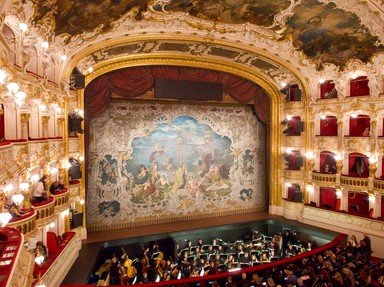Quiz Answer Key and Fun Facts
1. In 1789, only a year after the First Fleet arrived in Botany Bay, the play 'The Recruiting Officer' was performed in the small settlement of Sydney. To honour which monarch's birthday was this first theatrical event staged on Australian soil? (Hint: the USA had different reasons to remember this man!)
2. During the late 1820s and early 1830s, both Sydney and Adelaide had theatres open with the same name. What was this name, reflecting Australia's close links with 'the Mother Country'?
3. Theatre flourished in Australia during the 1850s. What event, also occurring in the USA around the same time, led to a great increase in Australia's population and a massive demand for theatrical entertainment?
4. After moving to Melbourne, this Pennsylvania-born actor and entrepreneur made a rapid fortune from the play 'Struck Oil' in 1874 and astutely bought the Australian rights to the entire Gilbert & Sullivan repertoire. Who was this man whose name was still synonymous with Australian theatre productions over 100 years later?
5. Which highly controversial play of the late nineteenth century, written by Henrik Ibsen ten years earlier, made its Australian debut in the Princess Theatre, Melbourne in 1889? The play ends with Nora leaving her husband and children in attempt to to discover who she really was.
6. Arguably the most well-known actress in the world at that time, who played her famous role from 'La Dame aux Camélias' ('The Lady of the Camellias') to ecstatic and sold out audiences in Sydney in 1891?
7. Australian Federation in 1901 ushered in a new era of quintessentially Australian plays. One of the most famous emanated from a series of short sketches by Steele Rudd, published in 'The Bulletin' magazine in the late 1890s. What was the name of this play, which reflected the often comedic trials of Dad and Dave as they tried to come to terms with the new property they'd acquired under the Land Settlement Act?
8. Considered by many scholars as the most historically significant play in Australian theatre history, Ray Lawler wrote this play set in Melbourne in 1953. What is the name of this masterpiece that describes the annual reunion of sugarcane cutters 'Roo' Webber and 'Barney' Ibbot and explores the tensions arising from changing times and circumstances?
9. Australia has produced many wonderful playwrights, whose works can be seen on various stages almost every day of each year. Which of these talented people wrote plays including 'The Removalists' and 'Don's Party' (both from 1971), 'The Club' (1977) and 'Emerald City' (1987) along with over thirty others up until the end of 2012?
10. There have been many larger than life characters striding the boards of Australian stages over these first 200 years. Arguably the most flamboyant and outrageous is the inimitable Dame Edna Everage. Which Melbourne-born actor brought Dame Edna to life in the mid-1950s and was still playing this role (amongst many others) over 50 years later?
Source: Author
MikeMaster99
This quiz was reviewed by FunTrivia editor
looney_tunes before going online.
Any errors found in FunTrivia content are routinely corrected through our feedback system.

